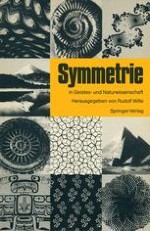1988 | OriginalPaper | Buchkapitel
On the Origin and Stability of Symmetries
verfasst von : René Thom
Erschienen in: Symmetrie in Geistes- und Naturwissenschaft
Verlag: Springer Berlin Heidelberg
Enthalten in: Professional Book Archive
Aktivieren Sie unsere intelligente Suche, um passende Fachinhalte oder Patente zu finden.
Wählen Sie Textabschnitte aus um mit Künstlicher Intelligenz passenden Patente zu finden. powered by
Markieren Sie Textabschnitte, um KI-gestützt weitere passende Inhalte zu finden. powered by
Perhaps the main difficulty attached to symmetry phenomena in Nature (and their most interesting aspect) lies in the fact that the concept of symmetry involves simultaneously both continuity and discontinuity. Symmetrical shapes or patterns are extended objects, hence requiring the existence of an ambient continuous space, the Cartesian “étendue”. But at the same time they exhibit an intrinsic order, mathematically implemented by a set of operations (a continuous or discrete group) which keep this object invariant. Both continuity and discontinuity occur in the mathematical theory of Lie groups (continuous groups such as rotation groups, Euclidean groups, etc.). But in the “real” physical world, the “ultimate reality” is usually thought to be made up of discontinuous elements, particles or atoms. Hence two fundamentally distinct ways of understanding the phenomena of symmetry. Either symmetry is created by the mutual interaction of underlying punctual discrete elements — this would be the “a posteriori” type of symmetry — or symmetry is postulated “a priori” and creates its own visible objects, like “symmetry-breakings” or “defects” — this will be the “a priori” approach. It should be said – at this point — that in Fundamental Physics, both Lie groups of symmetries and “particles” are postulated, hence the strategy of Physics is a (bastard) mixture of the two approaches. Of course the need to take into account the results of empirical observation and experimentation explains this situation. So let us start with some generalities about the empirical facts of symmetries.
